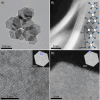Characterization of the Edge States in Colloidal Bi2Se3 Platelets
- PMID: 38624179
- PMCID: PMC11066965
- DOI: 10.1021/acs.nanolett.3c04460
Characterization of the Edge States in Colloidal Bi2Se3 Platelets
Abstract
The remarkable development of colloidal nanocrystals with controlled dimensions and surface chemistry has resulted in vast optoelectronic applications. But can they also form a platform for quantum materials, in which electronic coherence is key? Here, we use colloidal, two-dimensional Bi2Se3 crystals, with precise and uniform thickness and finite lateral dimensions in the 100 nm range, to study the evolution of a topological insulator from three to two dimensions. For a thickness of 4-6 quintuple layers, scanning tunneling spectroscopy shows an 8 nm wide, nonscattering state encircling the platelet. We discuss the nature of this edge state with a low-energy continuum model and ab initio GW-Tight Binding theory. Our results also provide an indication of the maximum density of such states on a device.
Keywords: Bismuth selenide nanoplatelets; Density functional theory; Edge state; Quantum spin Hall insulator; Scanning tunneling spectroscopy; Topological insulator.
Conflict of interest statement
The authors declare no competing financial interest.
Figures




 = 1. (D, E) Similar,
but now for a ribbon
cut in the direction perpendicular, to (C). Valence and conduction
bands are connected by an edge state (red) in line with
= 1. (D, E) Similar,
but now for a ribbon
cut in the direction perpendicular, to (C). Valence and conduction
bands are connected by an edge state (red) in line with  = 1. (F) The GW-TB calculated
density of
states in the interior of the ribbon (blue) with a peak corresponding
to the top of the valence band (set at −0.8 eV with respect
to the Fermi level) and showing the increasing density of states corresponding
to the 4 lowest (doubly degenerate) conduction bands. Red-solid: density
of states located at the edge with a zigzag like termination, corresponding
to panels B and C. Red-dashed: density of states at the edge corresponding
to the ribbon in panel E. Note that the experimental edge state width
(10 nm) is broader than the ball-and-stick schemes shown in panels
C and E.
= 1. (F) The GW-TB calculated
density of
states in the interior of the ribbon (blue) with a peak corresponding
to the top of the valence band (set at −0.8 eV with respect
to the Fermi level) and showing the increasing density of states corresponding
to the 4 lowest (doubly degenerate) conduction bands. Red-solid: density
of states located at the edge with a zigzag like termination, corresponding
to panels B and C. Red-dashed: density of states at the edge corresponding
to the ribbon in panel E. Note that the experimental edge state width
(10 nm) is broader than the ball-and-stick schemes shown in panels
C and E.References
-
- Lhuillier E.; Guyot-Sionnest P. Recent Progresses in Mid Infrared Nanocrystal Optoelectronics. IEEE J. Sel. Top. Quantum Electron. 2017, 23, 1–8. 10.1109/JSTQE.2017.2690838. - DOI
LinkOut - more resources
Full Text Sources

